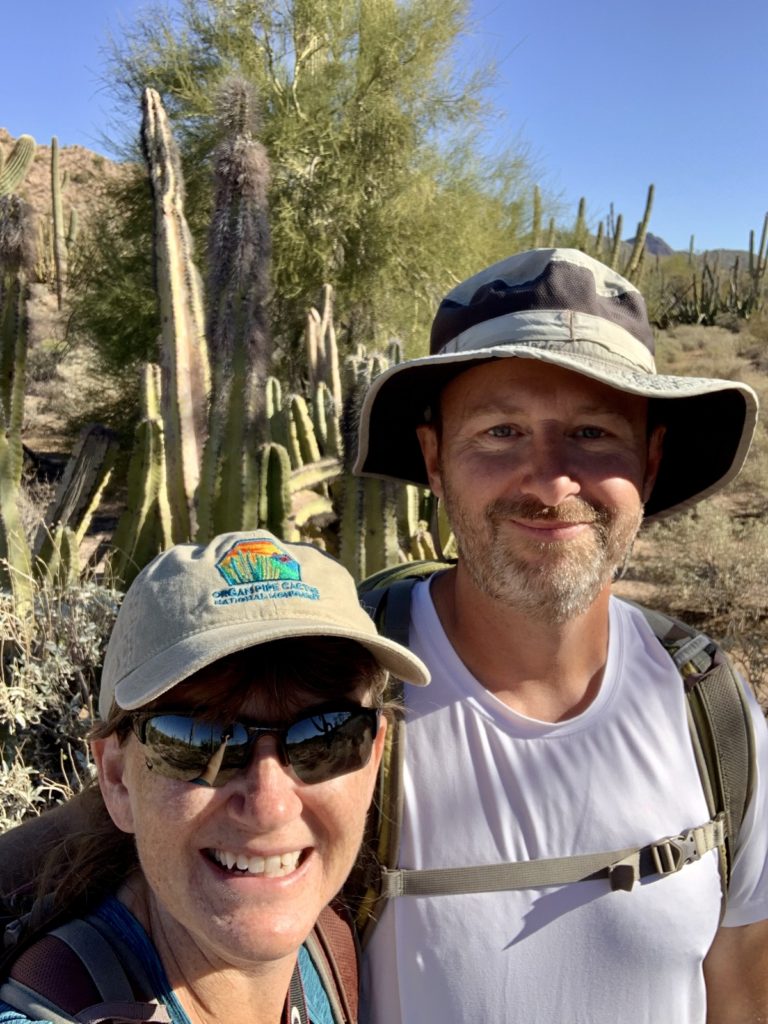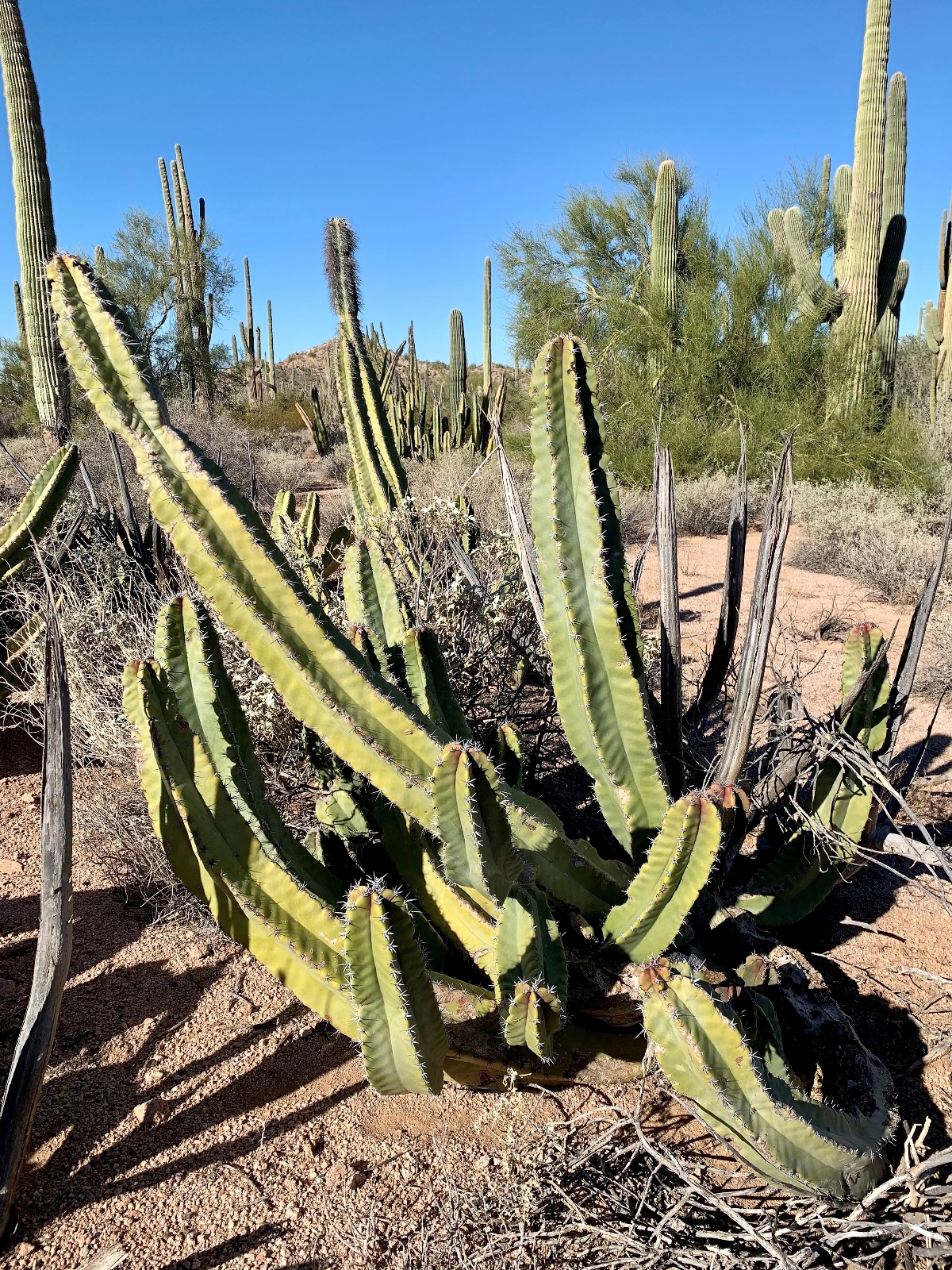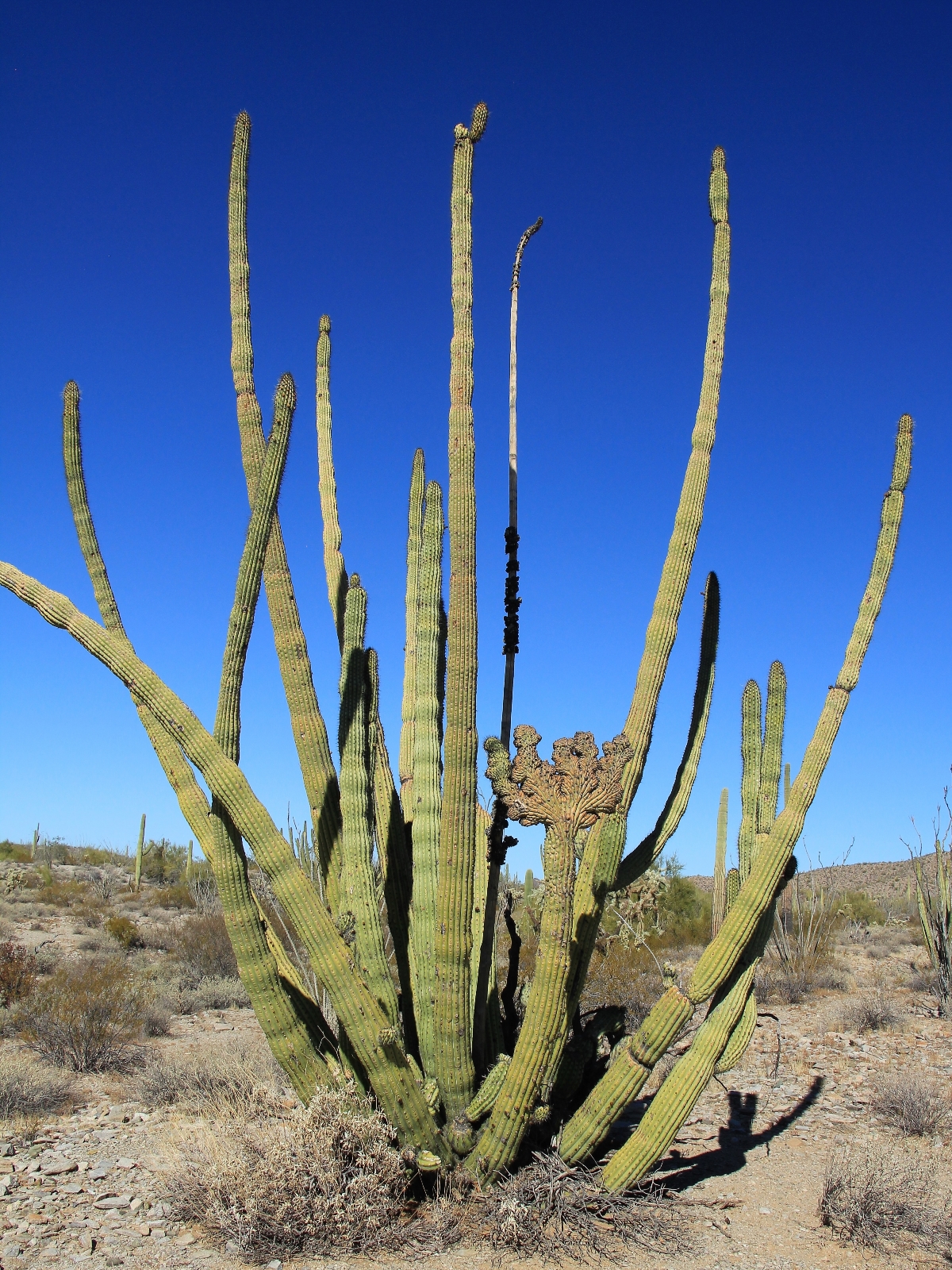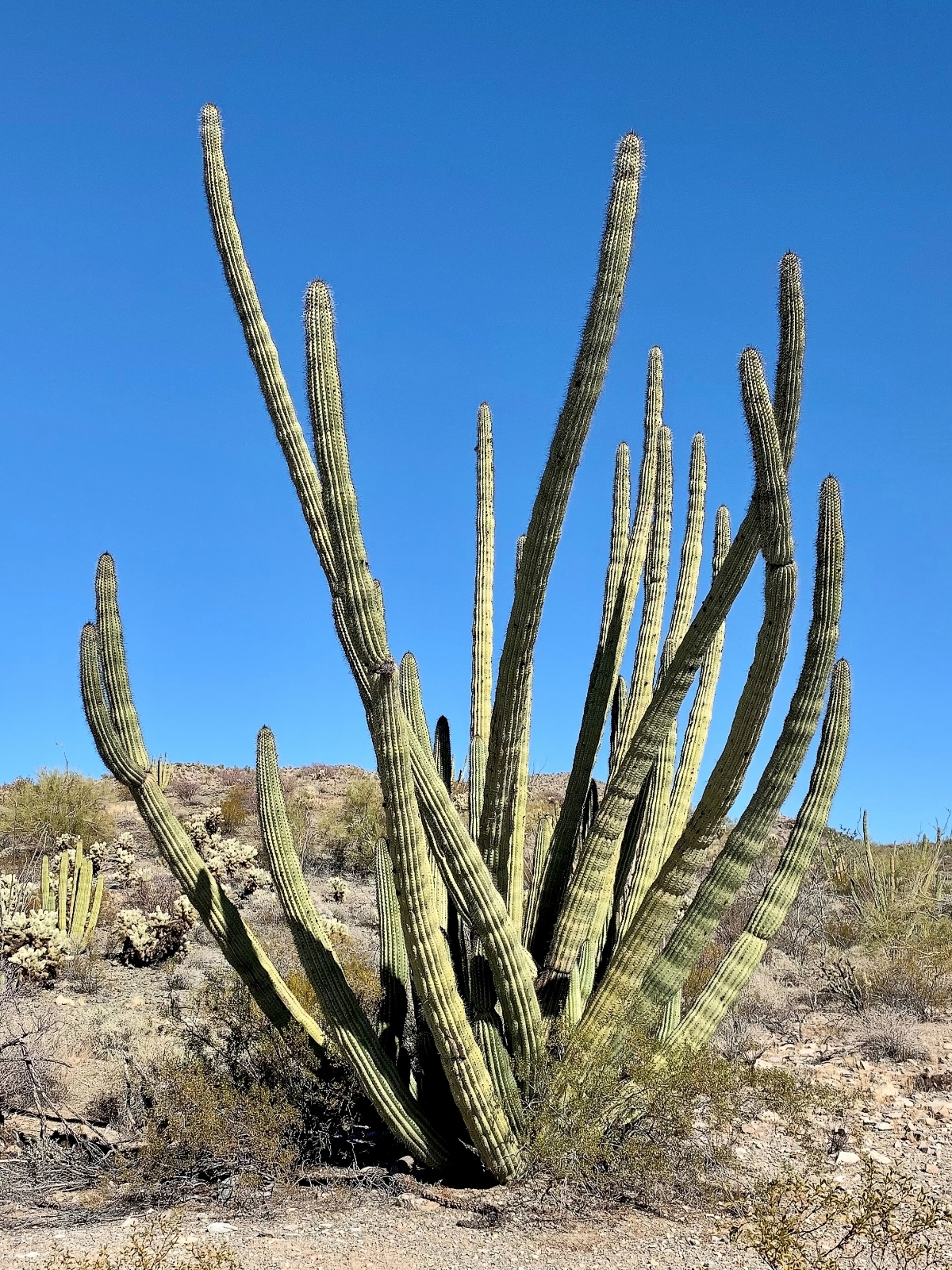Like most, I had never heard of the senita cactus. While researching for our trip to Organ Pipe Cactus National Monument, I learned that the monument is home to the only naturally growing population of senita cacti in the U.S. Their population is quite small and they are found only in isolated pockets. The naturalist in me had to see them and thus began our trek to find the elusive senita cactus.

The Senita Cactus
Senita cacti are quite common in Sonora, Mexico and Baja California, but only a few hundred grow north of the US-Mexican border. They are found in isolated pockets in Organ Pipe with the majority being located in Senita Basin. While they are more frost tolerant than organ pipe, they prefer highly arid habitats and the fine-textured soils of valley bottoms and thus do not occur as far north as the organ pipe.
Senita have pale pink flowers that emerge April through August to be pollinated by a specific species of moth. They grow 10 to 13 feet tall with multiple arms coming from the base, like the organ pipes. But unlike organ pipes, their ascending arms only have 5 to 7 accordion-like pleats. Long gray bristles grow on the ends of mature stems giving the tips a shaggy, bearded appearance. This has inspired common names like “whisker cactus” and “old man cactus.” Once we knew these key features, it was easy to spot the senitas in a sea of organ pipe cacti.



Where to Find Senita
For those who know where to look, it is actually quite easy to see senita cacti. You don’t even have to get out of your car! Travel south from the Visitor Center to near the U.S.-Mexican border and turn west on South Puerto Blanco Drive. Turn north onto Senita Basin Road and follow it to its end. The small section of Senita Basin Road that we saw was pretty well-maintained and any carefully driven passenger vehicle could have made the drive; however, conditions do change and the Park Service warns that there can be areas of deep sand requiring 4WD. Travel at your own risk! The road terminates in Senita Basin which is surprisingly lush and is one of the few places you can see all three of the monument’s columnar cacti coexisting (saguaro, organ pipes, and senita). The most impressive groves of senita are along the final mile of the Senita Basin Road after it turns east. There is a picnic table at the end of the road. This is an especially pretty location to stop and have a picnic lunch.

We could have easily made the drive to Senita Basin to see this rare species. But you know us, we prefer to hike when given the opportunity! An out-and-back hike from the campground is an option a lot of people choose, but we opted for a lovely 11.0 mile lollipop loop that included the Red Tanks and Baker Mine trails. We started at the Red Tanks Trailhead located at a pullout along North Puerto Blanco Drive a few miles from the visitor center. The road was well-maintained and easily accessible by any passenger vehicle. The trailhead wasn’t particularly well signed though, so be sure to keep a close eye out. The Red Tanks Trail was easy with nice views of the Puerto Blanco Mountains.



At 0.8 miles, we came to a fork in the trail and the beginning of the loop portion of our hike. We’d be returning via the Baker Mine Trail to the right, but for now we went left toward Senita Basin. The 2.4 mile leg to Senita Basin started by dropping down into a wide wash for about a mile before climbing out and continuing through a lovely area of saguaro and organ pipe cacti.



At 3.2 miles from the trailhead, the trail ended and we found ourselves merging onto the Senita Basin Road. It was time to start looking for senita cacti! We didn’t have to walk far before we began seeing them on both sides of the road. Some were about our height while others towered above us with their arms reaching over our heads like scary monsters. In all, we spotted a couple dozen senitas over a stretch of about a half a mile.



The cactus is only part of the story of Senita Basin. The Old Sonoyta Road, connecting the town of Ajo with Mexico, crossed the eastern end of the basin. Miners in the late 1800s and early 1900s found the colorful granitic rocks to be heavily mineralized and old prospect holes still dot the surrounding hillsides. Abandoned roads, slowly being reclaimed through time, lead to the remains of historic silver, copper, and gold mines.




After roughly a mile of hiking on the Senita Basin Road, we came to the Baker Mine Trail. The trail is an old road that leads 1.6 miles to the Milton Mine before continuing on to the Baker Mine. Milton Mine is one of the larger complexes of mines within the monument. Jeff Milton filed the first claim at this site. In addition to being a prospector, Jeff was the first Border Patrol agent between Nogales and Yuma. He was tasked with stopping the illegal immigration of Chinese people into the United States. Milton did not operate the claim long before he sold it. Like many of the mines in the area, it seemed to generate more money from the sale of paper than through the extraction of ore.

As we were hiking between Senita Basin and Milton Mine, Jason spotted a beautiful cristate organ pipe cactus. I hadn’t heard any references to their being such a fine specimen along this trail, so it was a fun surprise. A cristate or “crested” organ pipe and saguaro cactus forms when the cells in the growing stem begin to divide outward rather than in the circular pattern of a normal cactus. This is an unusual mutation which results in the growth of a large fan-shaped crest at the growing tip of the main stem or arms. Cristate saguaro and organ pipe are fairly rare. I couldn’t find any stats for cristate organ pipe, but of the estimated 1.9 million saguaros within the boundaries of Saguaro National Park, only 57 cristate saguaros have been documented (according to the National Park Service). Good spotting Jason!!



Past Milton Mine, the trail continued another 1.4 miles to the Baker Mine and then down another 1.8 miles back to the junction of the Red Tanks Trail. Over those 3.2 miles, we had some elevation change over rocky trail as we went up and over the Puerto Blanco Mountains. We passed hillsides teaming with organ pipe cactus and even had some lovely views of the Ajo Mountains to the east. The highlight of this stretch was getting to see about a dozen ocotillo (pronounced oh-koh-TEE-yohs) in bloom. This was a surprise considering they only bloom once in the spring, usually from March through June.






Once back at the Red Tanks Trail junction, it was a quick and easy 0.8 miles back to the truck. It had been an enjoyable day on the trail. We hiked 11.0 miles (justification for dessert after dinner?), saw rare cacti, visited some historical sites, saw ocotillos in early bloom, found a beautiful cristate organ pipe, and we only saw one person the entire day!

The Adventure Continues
Be sure to join us on our next adventure as we continue our Organ Pipe Cactus National Monument explorations, this time along the monument’s most popular scenic drive. And don’t forget to check out our Amazon RV and Adventure Gear recommendations. We only post products that we use and that meet the Evans Outdoor Adventures seal of approval. By accessing Amazon through our links and making any purchase (even things as simple as toothpaste!), you get Amazon’s every day low pricing and they share a little with us. This helps us maintain this website and is much appreciated!

How fun! Now I’ll have to go back to Organ Pipe to find the Senita’s. And that’s a very interesting cristate on that organ pipe cactus!
I was so proud of Jason for spotting that cristate! We’ll likely skip at least a year, but I can’t wait to go back. It would be fun to go together!
Very informative and interesting!